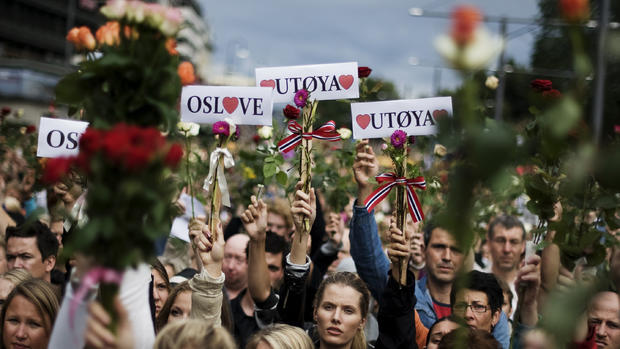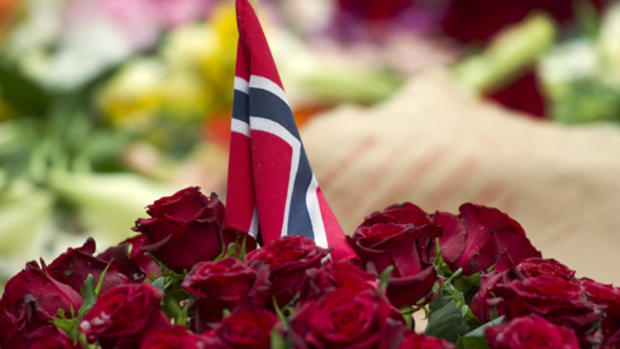A look back at the Norway massacre
On December 14, 2012, 20-year-old Adam Lanza killed a total of 27 people in Newtown, Conn., the majority of them children, before killing himself. It has since been revealed that he was at least in part inspired by another massacre several thousand miles away in northern Europe. Here is a look back at the horrific event that law enforcement officials told CBS News was part of the thinking that drove Lanza to commit such a terrible act.
On Friday, July 22, 2011, at around 3:30 p.m. local time, a 2,000-pound homemade fertilizer bomb planted in a car exploded and ripped through the central area of Norway's capital, Oslo, blowing out windows in government offices, killing 8 people, and wounding dozens more.
As police and rescue crews rushed to the scene, 33-year-old Anders Behring Breivik had already begun to make his way to a small island called Utoya, which is about 25 miles northwest of Oslo and was at the time hosting a camp for youth members of a Norwegian political party.
Breivik was dressed as a policeman and armed with an automatic rifle and a handgun. He later said he also brought drinking water because he knew the stress of killing people would dry his throat.
- Complete Coverage: Sandy Hook Elementary School shootings
- Complete Coverage: Massacre in Norway
- Newtown shooter motivated by Norway massacre, sources say
Before departing for the island, he allegedly told the ferry captain that transported him there that he was going to "do research in connection with the bomb blasts."
Breivik landed on the island about 5:30 p.m., and began shooting the adults and children trapped there.
In court almost a year later, Breivik described the reaction of his victims as surprising.
"Some of them are completely paralyzed. They cannot run. They stand totally still. This is something they never show on TV," Breivik said. "It was very strange."
Breivik's first two victims were a camp organizer and an off-duty police officer who was serving as a security guard.
"My whole body tried to revolt when I took the weapon in my hand. There were 100 voices in may head saying 'Don't do it, don't do it,"' Breivik said.
After he made sure his first two victims were dead, he then entered what he described as a "fight-and-flight modus" that made it easier to continue killing.
At around 6:00 p.m., Breivik called Norway's equivalent of "911" to surrender and hung up. He then went on shooting people. Again at around 6:30, he called the emergency line to surrender and hung up. At approximately 6:34 p.m., he surrendered without a fight to police. He had killed 67 people and wounded 33 more by then. Two more people eventually died in the hospital. He later said in court he had hoped to kill all 600 on the island.
Breivik was ultimately ruled sane by Norwegian courts, but the many motivators he has described since the massacre make his impulsions hard to pin down.
He has at times cited Oklahoma City bomber Timothy McVeigh, the Knights Templar, al Qaeda, "Unabomber" Ted Kaczynski, Japanese "banzai" warriors, and other as all having inspired and informed his rampage.
In testimony, he has said he was outraged at the softening of European culture, and even cited American folk music singer Pete Seeger's "Rainbow Race" as an example of how he believes "cultural Marxists" have infiltrated Norwegian schools.
In Internet postings attributed to Breivik, he blamed Europe's left-wing parties for destroying the continent's Christian heritage by allowing mass immigration of Muslims. Breivik has said he was in touch with like-minded individuals across Europe, and together they had made a military order with the goal of conquering the continent by 2083 in a string of coups, though officials have not released any evidence to back up that claim.
Breivik said he trained for the massacre by playing the "Call of Duty" video game in order to "develop target acquisition." Prosecutors say Breivik also played "World of Warcraft" an average of six hours and 50 minutes daily from November 2010 to February 2011 before beginning to build bombs he eventually used in his Oslo attack.
These days, Breivik is serving out the 21-year prison sentence handed to him by Norway's courts, which is the maximum amount of time any law breaker in Norway can receive. Officials in Norway have defended the sentence by saying it can always be extended if he is still considered a danger to society.
Like many unhinged mass murderers, Breivik has inspired fans and acolytes and allegedly received letters of support from 20 countries. One American fan, Kevin Forts, told a Norwegian newspaper Breivik is a "nationalist and a patriot and not the terrorist neo-Nazi that the media portrays him to be."
Since being imprisoned, Breivik has regularly complained about the conditions he endures, despite Norway having one of the nicer prison systems in the world. He has written letters to officials with "a list of complaints ranging from everyday annoyances, like cold coffee and a lack of butter, to more serious issues, such as censorship of his correspondence, body searches, and being kept in isolation."

